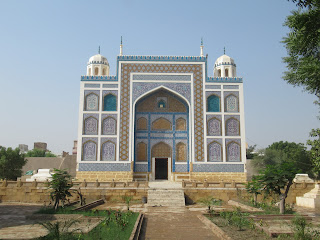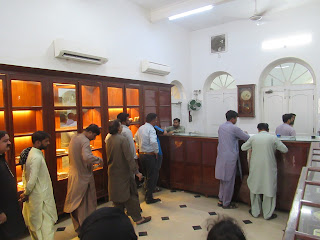Hyderabad
It was going to be a day of mosques and mausoleums. Our first stop was at the Eid Gah mosque in Hyderabad. It was built in 1947 to celebrate independence.The central path.
One of thr minarets.
The main mosque building. It it largely used for Eid prayers.
We crossed the Kotri Barrage. It was built in 1955. It is used to control flood water and for irrigation purposes. To the east, it feeds the small Akram Wah canal and the large Phuleli Canal which soon splits into two to irrigate different areas. To the west, it feds the Karachi Canal which is the main water suply for Karachi.
A view of the downstream gates, five of which are open.
A close up of one of the gates.
We recrossed the barrage and stopped at the Mian Ghulam NabiKalhoro tomb.
It is octagonal in floor plan...
...with a simple stone coffin. He was a king and not a religious man so there is no surrounding wooden lattice work. he ruled in 1775 - 1776. In contrat to the many other shrines and tombs, the inside decortion of this one was rather plain.
Just along the road is the tomb of Mian Ghulam Shah Kalhoro. He was the founder of Hyderabad and ruled 1757 - 1772. The entrance looks more like the entrance to a fort with stout bastions and a crooked approch...
...to th main ornamental gate to the tomb complex.
Th tomb is square in plan...
...with ornate and colourful decorations.
A view of the mihrab in the western wall.
A detail of the decorstion in one of the corners. The dome has been replaced with a flat roof.
Another museum on the schedule, but it was closed.It is octagonal in floor plan...
...with a simple stone coffin. He was a king and not a religious man so there is no surrounding wooden lattice work. he ruled in 1775 - 1776. In contrat to the many other shrines and tombs, the inside decortion of this one was rather plain.
Just along the road is the tomb of Mian Ghulam Shah Kalhoro. He was the founder of Hyderabad and ruled 1757 - 1772. The entrance looks more like the entrance to a fort with stout bastions and a crooked approch...
...to th main ornamental gate to the tomb complex.
Th tomb is square in plan...
...with ornate and colourful decorations.
A view of the mihrab in the western wall.
The Holm Stead Hall.
A detail of the corner.It was built as a memorial in 1905 to Mr Holm Stead who was a surgeon here in 1854 - 1868 and provided valueable service during the cholera outbreak in the region. The building became a radio station after independence in 1947 although after the radio station moved out, it fell into disrepair. It was renovated in 2008 and became a library.
Another view of the insides...
,,,and a view of the side facade.
We passed through an old Hindu quarter...
...another Hindu quarter building...
...to reach the clock tower and bazaar.
The start of the bazaar.
A car soare parts market, not that I am keen on cars but it was en route to the next shrine.
We were visiting the Shah Abdul Latif Kazmi shrine with an elaborately decorated flagpole. There is a sacred relic here of a foorprint of the Imam Ali on a stone. He is one of the five most important figures, the others being Muhammad, Fatima, Husain and Sajid.
The mosque on the site.
The steps up to the shrine although photos are not allowed inside.
We stopped at the gates to the Bombay Bakery, set up here by Pahlajrai Gangaram Thadani in 1911.
The entrance to th shop.
Another section of heavily eroded wall.
Inside the shop with coffee and marzipan cakes on display within mahogany and glass display cabinets.
Next stop ws the railway station, a long mainly lofty single storey white washed building.
A locomotive on display outside.
A cafe located in a railway crriage, regretably closed when we visited.
Looking across some of the traks and rolling stock towards the two storey part of the station.
A diesel locomotive about to pull out of the station.

Looking at rolling stock in the station from a footbridge.

A detail of the station.
Looking across some of the traks and rolling stock towards the two storey part of the station.
A diesel locomotive about to pull out of the station.

Looking at rolling stock in the station from a footbridge.

A detail of the station.
I wanted to see the fort, but there is little to see of interest. A small section of outer wall has been rebuilt to show what it used to look like
Much of the rest of the former fort walls have lost their facing bricks and the mud brick core is exposed and suffering from erosion.Another section of heavily eroded wall.










































No comments:
Post a Comment